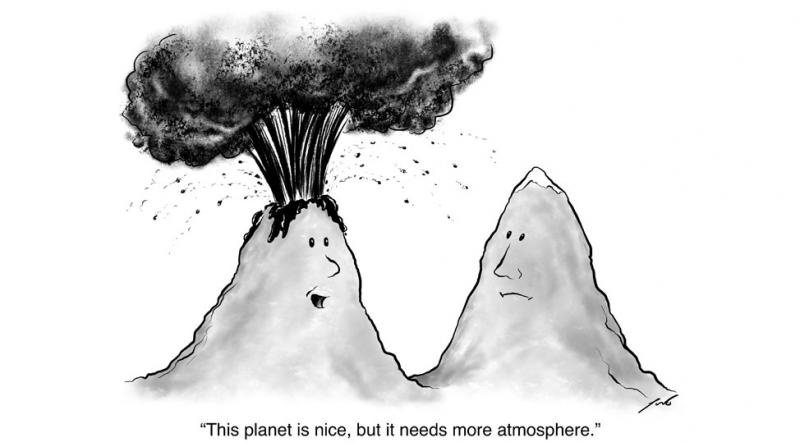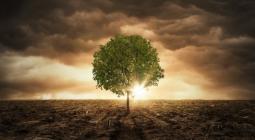ASK SARA: Where did the climate come from?' and other kids' questions about climate change

Inquiring children want to know what will happen if sea levels rise, how to talk about climate change with friends at school, and more.
Dear readers,
As a child, I was a frequent visitor to the magnificent Museum of Life and Science in Durham, North Carolina, an 84-acre facility where I learned, among many other things, how to dissect owl pellets. So I was thrilled when the museum recently invited me to help answer questions about climate change posed by today’s generation of young learners. Participants in the museum’s online educational programs, whose ages typically range as old as 13, were invited to send questions. I’m replying to those questions in two parts, one published today and another still to come.
Where did the climate come from? How was it formed? (Carlyle, age 9)
Dear Carlyle,
Our climate began forming at the same time as our solar system. The solar system includes the sun, the Earth, the moon, other nearby planets, and more. It began a long, long time ago: about 4.5 billion years.
All of the planets in our solar system travel around our sun along paths called orbits. Earth got lucky. Our planet’s orbit is not too close to the sun, and it’s not too far, either. Because Earth is not too close or too far, our climate is not too hot or too cold for the plants, animals, and other creatures that live here.
Other planets have orbits that are closer or farther away from the sun than ours. That means they have much different climates. Mercury is closest to the sun, for example, and it can get scorching hot. Think about how hot water is when people boil it to make tea or cook food. That water is 212 degrees Fahrenheit. Compare that to Mercury, where the temperature during the daytime can rise up to 800 degrees Fahrenheit.
On the other hand, the planet Mars’s orbit is farther away from the sun than the Earth’s. And it gets chilly on Mars! When heavy snow falls here on Earth, the temperature outside is usually between 15 and 32 degrees Fahrenheit. But the average temperature on Mars is -81 degrees Fahrenheit.
When Earth formed about 4.5 billion years ago, it was much different from the planet we know today. Now we have an atmosphere, which is the layer of air surrounding Earth. This atmosphere is also important for our climate.
But when the Earth first began, it didn’t have much of an atmosphere at all. When our planet was still very young, many volcanoes erupted and spewed gases from beneath the ground. Those gases created our planet’s first atmosphere.
We are very lucky to have an atmosphere. Some of the gases in our atmosphere trap a small amount of heat around the Earth, like the blanket that keeps you warm on cold winter nights. If we didn’t have those gases, the average temperature of our planet today would be about zero degrees Fahrenheit. That’s cold enough to freeze all of the water on Earth – not a comfortable climate!
Since the beginning of Earth, our climate has slowly changed many times. Sometimes the climate has gradually gotten cooler, and sometimes it has grown warmer. The oceans, ice sheets, volcanoes, atmosphere, sun, and living creatures all have an influence on the climate. You can see that Earth’s climate is complicated, but that’s one reason it’s also so interesting.
What is changing the climate now? (Rupi, age 7)
Dear Rupi,
Before you were born, people discovered some stuff called coal, oil, and natural gas. These things were buried deep underneath the ground. The people dug down into the earth and drilled big holes to get the coal, oil, and natural gas and bring it back up to the surface. They were very excited because they realized they could use these things to make wonderful creations.
Let me tell you about those creations. A long time ago, people used to walk or ride on horses to get around. But as they started getting the oil from the ground, they realized they could turn that oil into gasoline and other fuels. They invented cars, trucks, and airplanes that burned that fuel for energy. The cars and trucks could drive much faster than a person could walk or a horse could gallop. Airplanes zoomed through the sky even faster than that. People walked less and stopped riding their horses. They started driving and flying instead.
They invented other wonderful things, too. Factories that burned coal for fuel could create new clothes and other products very quickly. People built power plants that burned coal and natural gas to send electricity to people’s homes. They invented dishwashers, lightbulbs, refrigerators, air conditioning, and other amazing devices that used electricity from those power plants.
But what they did not realize at first was that when they used coal, oil, and natural gas, something strange was happening. When they burned those fuels, a gas called carbon dioxide floated into the atmosphere.
Remember when I wrote that some gases trap heat in the atmosphere, like a blanket? Carbon dioxide is one of those gases. When too much of it floats into the atmosphere, it traps too much heat around us. It’s like having a lot of blankets around you when you’re sleeping at night. You start to get hot and sweaty.
The climate is getting warmer from the extra carbon dioxide that floats away when we burn coal, oil, and natural gas. For that reason, many people think that it is time for us to stop using those fuels and try some other inventions instead.
What will happen if the sea levels rise? (no name given)
In some areas along the coast, the sea levels have already started to rise. In cities like Miami, Florida, Charleston, South Carolina, Wilmington, North Carolina, Norfolk, Virginia, and New York City, for example, people are noticing that water from the ocean is sneaking into places where it didn’t used to go. When I was visiting near the beach in South Carolina, my family and I saw water from the ocean that was flooding the roads.

In some places near the ocean, the water sometimes gets so deep on the roads that people can’t drive their cars on it. At other times, the water can even get into the bottom of people’s houses and make the floors wet. That can make kids and grown-ups feel angry, scared, or sad.
If the sea levels keep rising, the ocean water will sneak onto the land more often. As that happens, many people will probably decide they don’t want to live in those places anymore. Plants, animals, and other creatures living near the beach will not like the water very much, either. It will be time for everyone to move uphill, away from the ocean.
How do I talk about this with my friends at school? (no name given)
To help me answer your question, I wrote an email to Professor Ann Sanson, who lives in Australia. She knows a lot about talking with kids about climate change. She was interested in your question and she wrote back with ideas.
She suggested that you begin by thinking of one way that climate change is affecting your community. In many places in the United States, for example, heat waves are more common now than they used to be. Once you have an example in mind, ask your friends what they know about it and how they feel about it, she said.
“Be interested and supportive and understanding of their reactions. Don’t get angry or criticize them,” she added. In other words, it’s important to listen carefully.
After you’ve listened, you can explain how you feel. You might say that you’re worried about heat waves happening more often. You can explain what you know about how heat waves are related to climate change.
Then, you might tell your friends that you are worried about climate change and how it will affect your future and the natural world, Professor Sanson said.
Next, talk with your friends about what people can do to help the climate. If you’re already doing something to help the climate, like turning off lights when you leave a room or writing letters to government leaders, you can share those examples with your friends.
“Tell them how you feel more hopeful when you do something about the problem, and (if relevant) how doing things together with others is more fun and more effective and that you can learn lots by doing so,” she said.
Ask your friends if they would like to do something together to help the climate. Here are some examples that Professor Sanson suggested: contacting your local politician, putting up signs on your house, asking your school to get solar power, or participating in school strikes for climate.
If your friends say they are not interested in joining you, that’s OK. “Say you’re happy you’ve been able to talk about it with them,” she said. “It helps you when you can share your feelings.”
You don’t have to talk about all of these things at once. You can always say, “Let’s talk about this some more later.”
Good luck talking with your friends. It is one of the most important ways you can help the climate.
Thank you to all of you for your fantastic questions.
– Sara
YALE CLIMATE CONNECTIONS





